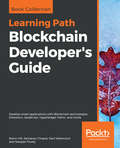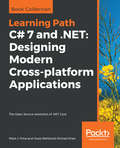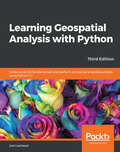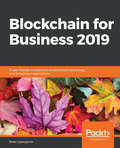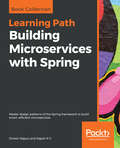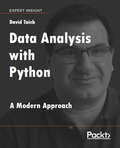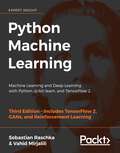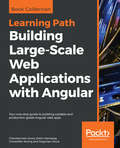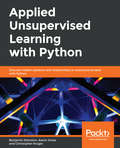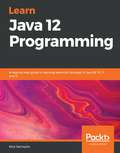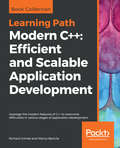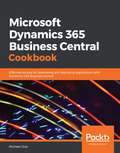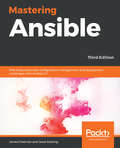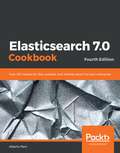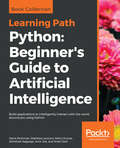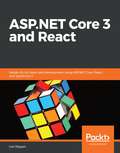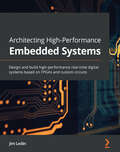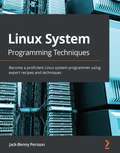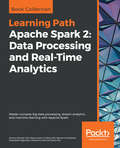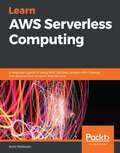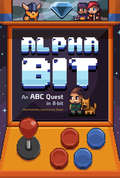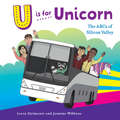- Table View
- List View
Learning Path - Getting Started with Blockchain: Develop Smart Applications With Blockchain Technologies - Ethereum, Javascript, Hyperledger Fabric, And Corda
by Samanyu Chopra Narayan Prusty Brenn Hill Paul ValencourtGetting Started with Blockchain is for you if you want to get to grips with the blockchain technology and develop your own distributed applications. It is also designed for those who want to polish their existing knowledge regarding the various pillars of the blockchain ecosystem. Prior exposure to an object-oriented programming language such as JavaScript is needed.
Learning Path - C# 7 and .NET: The Open Source Revolution Of . Net Core
by Mark J. Price Ovais Mehboob KhanThis Learning Path is designed for developers who want to gain a solid foundation with C# and .NET Core, and want to build cross-platform applications. To gain maximum benefits from this Learning Path, you must have the basic knowledge of C#.
Learning Geospatial Analysis with Python: Understand GIS fundamentals and perform remote sensing data analysis using Python 3.7, 3rd Edition
by Joel LawheadLearn the core concepts of geospatial data analysis for building actionable and insightful GIS applications Key Features Create GIS solutions using the new features introduced in Python 3.7 Explore a range of GIS tools and libraries such as PostGIS, QGIS, and PROJ Learn to automate geospatial analysis workflows using Python and Jupyter Book Description Geospatial analysis is used in almost every domain you can think of, including defense, farming, and even medicine. With this systematic guide, you'll get started with geographic information system (GIS) and remote sensing analysis using the latest features in Python. This book will take you through GIS techniques, geodatabases, geospatial raster data, and much more using the latest built-in tools and libraries in Python 3.7. You'll learn everything you need to know about using software packages or APIs and generic algorithms that can be used for different situations. Furthermore, you'll learn how to apply simple Python GIS geospatial processes to a variety of problems, and work with remote sensing data. By the end of the book, you'll be able to build a generic corporate system, which can be implemented in any organization to manage customer support requests and field support personnel. What you will learn Automate geospatial analysis workflows using Python Code the simplest possible GIS in just 60 lines of Python Create thematic maps with Python tools such as PyShp, OGR, and the Python Imaging Library Understand the different formats that geospatial data comes in Produce elevation contours using Python tools Create flood inundation models Apply geospatial analysis to real-time data tracking and storm chasing Who this book is for This book is for Python developers, researchers, or analysts who want to perform geospatial modeling and GIS analysis with Python. Basic knowledge of digital mapping and analysis using Python or other scripting languages will be helpful.
Blockchain for Business 2019: A user-friendly introduction to blockchain technology and its business applications
by Peter LipovyanovYour one-stop guide to blockchain technology and its business applications Key Features Assimilate blockchain services such as Ethereum and Hyperledger to transform industrial applications Know in and out of blockchain technology to understand various business use cases Understand various common and not-so-common challenges faced in blockchain development Book Description Blockchain for Business 2019 is a comprehensive guide that enables you to bring in various blockchain functionalities to extend your existing business models and make correct fully-informed decisions. You will learn how decentralized applications are transforming numerous business sectors that are expected to play a huge role in the future. You will see how large corporations are already implementing blockchain technology now. You will then learn about the various blockchain services, such as Bitcoin, Ethereum, Hyperledger, and others to understand their use cases in a variety of business domains. You will develop a solid fundamental understanding of blockchain architecture. Moving ahead, you will get to grips with the inner workings of blockchain, with detailed explanations of mining, decentralized consensus, cryptography, smart contracts, and many other important concepts. You will delve into a realistic view of the current state of blockchain technology, along with its issues, limitations, and potential solutions that can take it to the next level. By the end of this book, you will all be well versed in the latest innovations and developments in the emerging blockchain space. What you will learn Understand the fundamentals of blockchain and how it was developed Gain a good understanding of economic concepts and developments Develop a base for concepts such as cryptography, computer networking, and programming Understand the applications of blockchain and its potential impact on the world Become well versed with the latest developments in the blockchain space Explore blockchain frameworks, including decentralized organizational structures, networks, and applications Who this book is for This book is for financial professionals, business executives, managers, and enthusiasts who are interested in getting well-versed with blockchain technology in various business domains. This book will help boost your existing business models using blockchain services. No prior experience of blockchain is required.
Learning Path - Getting Started with Spring Microservices: Master design patterns of the Spring framework to build smart, efficient microservices
by Rajesh R V Dinesh RajputGetting Started with Spring Microservices is ideal for Spring developers who want to use design patterns to solve common design problems and build cloud-ready, Internet-scale applications, and simple RESTful services.
Data Analysis with Python: A Modern Approach
by David TaiebLearn a modern approach to data analysis using Python to harness the power of programming and AI across your data. Detailed case studies bring this modern approach to life across visual data, social media, graph algorithms, and time series analysis. Key Features Bridge your data analysis with the power of programming, complex algorithms, and AI Use Python and its extensive libraries to power your way to new levels of data insight Work with AI algorithms, TensorFlow, graph algorithms, NLP, and financial time series Explore this modern approach across with key industry case studies and hands-on projects Book Description Data Analysis with Python offers a modern approach to data analysis so that you can work with the latest and most powerful Python tools, AI techniques, and open source libraries. Industry expert David Taieb shows you how to bridge data science with the power of programming and algorithms in Python. You'll be working with complex algorithms, and cutting-edge AI in your data analysis. Learn how to analyze data with hands-on examples using Python-based tools and Jupyter Notebook. You'll find the right balance of theory and practice, with extensive code files that you can integrate right into your own data projects. Explore the power of this approach to data analysis by then working with it across key industry case studies. Four fascinating and full projects connect you to the most critical data analysis challenges you're likely to meet in today. The first of these is an image recognition application with TensorFlow – embracing the importance today of AI in your data analysis. The second industry project analyses social media trends, exploring big data issues and AI approaches to natural language processing. The third case study is a financial portfolio analysis application that engages you with time series analysis - pivotal to many data science applications today. The fourth industry use case dives you into graph algorithms and the power of programming in modern data science. You'll wrap up with a thoughtful look at the future of data science and how it will harness the power of algorithms and artificial intelligence. What you will learn A new toolset that has been carefully crafted to meet for your data analysis challenges Full and detailed case studies of the toolset across several of today's key industry contexts Become super productive with a new toolset across Python and Jupyter Notebook Look into the future of data science and which directions to develop your skills next Who this book is for This book is for developers wanting to bridge the gap between them and data scientists. Introducing PixieDust from its creator, the book is a great desk companion for the accomplished Data Scientist. Some fluency in data interpretation and visualization is assumed. It will be helpful to have some knowledge of Python, using Python libraries, and some proficiency in web development.
Python Machine Learning: Machine Learning and Deep Learning with Python, scikit-learn, and TensorFlow 2, 3rd Edition
by Sebastian Raschka Vahid MirjaliliApplied machine learning with a solid foundation in theory. Revised and expanded for TensorFlow 2, GANs, and reinforcement learning.Key FeaturesThird edition of the bestselling, widely acclaimed Python machine learning bookClear and intuitive explanations take you deep into the theory and practice of Python machine learningFully updated and expanded to cover TensorFlow 2, Generative Adversarial Network models, reinforcement learning, and best practicesBook DescriptionPython Machine Learning, Third Edition is a comprehensive guide to machine learning and deep learning with Python. It acts as both a step-by-step tutorial, and a reference you'll keep coming back to as you build your machine learning systems.Packed with clear explanations, visualizations, and working examples, the book covers all the essential machine learning techniques in depth. While some books teach you only to follow instructions, with this machine learning book, Raschka and Mirjalili teach the principles behind machine learning, allowing you to build models and applications for yourself.Updated for TensorFlow 2.0, this new third edition introduces readers to its new Keras API features, as well as the latest additions to scikit-learn. It's also expanded to cover cutting-edge reinforcement learning techniques based on deep learning, as well as an introduction to GANs. Finally, this book also explores a subfield of natural language processing (NLP) called sentiment analysis, helping you learn how to use machine learning algorithms to classify documents.This book is your companion to machine learning with Python, whether you're a Python developer new to machine learning or want to deepen your knowledge of the latest developments.What you will learnMaster the frameworks, models, and techniques that enable machines to 'learn' from dataUse scikit-learn for machine learning and TensorFlow for deep learningApply machine learning to image classification, sentiment analysis, intelligent web applications, and moreBuild and train neural networks, GANs, and other modelsDiscover best practices for evaluating and tuning modelsPredict continuous target outcomes using regression analysisDig deeper into textual and social media data using sentiment analysisWho This Book Is ForIf you know some Python and you want to use machine learning and deep learning, pick up this book. Whether you want to start from scratch or extend your machine learning knowledge, this is an essential resource. Written for developers and data scientists who want to create practical machine learning and deep learning code, this book is ideal for anyone who wants to teach computers how to learn from data.
Learning Path - Professional Web Development with Angular: Your One-stop Guide To Building Scalable And Production-grade Angular Web Apps
by Chandermani Arora Kevin Hennessy Christoffer Noring Doguhan UlucaThis Learning Path is designed for JavaScript and frontend developers who want to get a comprehensive practical experience on using Angular for end-to-end enterprise-ready applications.
Applied Unsupervised Learning with Python: Discover hidden patterns and relationships in unstructured data with Python
by Benjamin Johnston Aaron Jones Christopher KrugerDesign clever algorithms that can uncover interesting structures and hidden relationships in unstructured, unlabeled dataKey FeaturesLearn how to select the most suitable Python library to solve your problemCompare k-Nearest Neighbor (k-NN) and non-parametric methods and decide when to use themDelve into the applications of neural networks using real-world datasetsBook DescriptionUnsupervised learning is a useful and practical solution in situations where labeled data is not available. Applied Unsupervised Learning with Python guides you on the best practices for using unsupervised learning techniques in tandem with Python libraries and extracting meaningful information from unstructured data. The course begins by explaining how basic clustering works to find similar data points in a set. Once you are well versed with the k-means algorithm and how it operates, you’ll learn what dimensionality reduction is and where to apply it. As you progress, you’ll learn various neural network techniques and how they can improve your model. While studying the applications of unsupervised learning, you will also understand how to mine topics that are trending on Twitter and Facebook and build a news recommendation engine for users. You will complete the course by challenging yourself through various interesting activities such as performing a Market Basket Analysis and identifying relationships between different merchandises. By the end of this course, you will have the skills you need to confidently build your own models using Python.What you will learnUnderstand the basics and importance of clusteringBuild k-means, hierarchical, and DBSCAN clustering algorithms from scratch with built-in packagesExplore dimensionality reduction and its applicationsUse scikit-learn (sklearn) to implement and analyse principal component analysis (PCA)on the Iris datasetEmploy Keras to build autoencoder models for the CIFAR-10 datasetApply the Apriori algorithm with machine learning extensions (Mlxtend) to study transaction dataWho this book is forThis course is designed for developers, data scientists, and machine learning enthusiasts who are interested in unsupervised learning. Some familiarity with Python programming along with basic knowledge of mathematical concepts including exponents, square roots, means, and medians will be beneficial.
Learn Java 12 Programming: A step-by-step guide to learning essential concepts in Java SE 10, 11, and 12
by Nick SamoylovA comprehensive guide to get started with Java and gain insights into major concepts such as object-oriented, functional, and reactive programmingKey FeaturesStrengthen your knowledge of important programming concepts and the latest features in JavaExplore core programming topics including GUI programming, concurrency, and error handlingLearn the idioms and best practices for writing high-quality Java codeBook DescriptionJava is one of the preferred languages among developers, used in everything right from smartphones, and game consoles to even supercomputers, and its new features simply add to the richness of the language. This book on Java programming begins by helping you learn how to install the Java Development Kit. You will then focus on understanding object-oriented programming (OOP), with exclusive insights into concepts like abstraction, encapsulation, inheritance, and polymorphism, which will help you when programming for real-world apps. Next, you’ll cover fundamental programming structures of Java such as data structures and algorithms that will serve as the building blocks for your apps. You will also delve into core programming topics that will assist you with error handling, debugging, and testing your apps. As you progress, you’ll move on to advanced topics such as Java libraries, database management, and network programming, which will hone your skills in building professional-grade apps.Further on, you’ll understand how to create a graphic user interface using JavaFX and learn to build scalable apps by taking advantage of reactive and functional programming.By the end of this book, you’ll not only be well versed with Java 10, 11, and 12, but also gain a perspective into the future of this language and software development in general.What you will learnLearn and apply object-oriented principlesGain insights into data structures and understand how they are used in JavaExplore multithreaded, asynchronous, functional, and reactive programmingAdd a user-friendly graphic interface to your applicationFind out what streams are and how they can help in data processingDiscover the importance of microservices and use them to make your apps robust and scalableExplore Java design patterns and best practices to solve everyday problemsLearn techniques and idioms for writing high-quality Java codeWho this book is forStudents, software developers, or anyone looking to learn new skills or even a language will find this book useful. Although this book is for beginners, professional programmers can benefit from it too. Previous knowledge of Java or any programming language is not required.
Learning Elastic Stack 7.0: Distributed search, analytics, and visualization using Elasticsearch, Logstash, Beats, and Kibana, 2nd Edition
by Pranav Shukla Sharath Kumar M NA beginner's guide to storing, managing, and analyzing data with the updated features of Elastic 7.0Key FeaturesGain access to new features and updates introduced in Elastic Stack 7.0Grasp the fundamentals of Elastic Stack including Elasticsearch, Logstash, and KibanaExplore useful tips for using Elastic Cloud and deploying Elastic Stack in production environmentsBook DescriptionThe Elastic Stack is a powerful combination of tools for techniques such as distributed search, analytics, logging, and visualization of data. Elastic Stack 7.0 encompasses new features and capabilities that will enable you to find unique insights into analytics using these techniques. This book will give you a fundamental understanding of what the stack is all about, and help you use it efficiently to build powerful real-time data processing applications.The first few sections of the book will help you understand how to set up the stack by installing tools, and exploring their basic configurations. You’ll then get up to speed with using Elasticsearch for distributed searching and analytics, Logstash for logging, and Kibana for data visualization. As you work through the book, you will discover the technique of creating custom plugins using Kibana and Beats. This is followed by coverage of the Elastic X-Pack, a useful extension for effective security and monitoring. You’ll also find helpful tips on how to use Elastic Cloud and deploy Elastic Stack in production environments. By the end of this book, you’ll be well versed with the fundamental Elastic Stack functionalities and the role of each component in the stack to solve different data processing problems.What you will learnInstall and configure an Elasticsearch architectureSolve the full-text search problem with ElasticsearchDiscover powerful analytics capabilities through aggregations using ElasticsearchBuild a data pipeline to transfer data from a variety of sources into Elasticsearch for analysisCreate interactive dashboards for effective storytelling with your data using KibanaLearn how to secure, monitor and use Elastic Stack’s alerting and reporting capabilitiesTake applications to an on-premise or cloud-based production environment with Elastic StackWho this book is forThis book is for entry-level data professionals, software engineers, e-commerce developers, and full-stack developers who want to learn about Elastic Stack and how the real-time processing and search engine works for business analytics and enterprise search applications. Previous experience with Elastic Stack is not required, however knowledge of data warehousing and database concepts will be helpful.
Learning Path - Modern C++: Efficient and Scalable Application Development
by Richard Grimes Marius BancilaThis Learning Path is designed for developers who want to gain a solid foundation with C++. A computer, an Internet connection, and the desire to learn how to code in C++ are all you need to get started with this Learning Path.
Microsoft Dynamics 365 Business Central Cookbook: Effective recipes for developing and deploying applications with Dynamics 365 Business Central
by Michael GlueGain useful insights to help you efficiently build, test, and migrate customized solutions on Business Central cloud and on-premise platforms Key Features Explore enhanced functionalities and development best practices in Business Central Develop powerful Business Central projects using the AL language Master the new Business Central with easy-to-follow recipes Book Description Microsoft Dynamics 365 Business Central is a complete business management solution that can help you streamline business processes, connect individual departments in your company, and enhance customer interactions. Ok. That first part was really professional sounding, right? Now, let's get into what this cookbook is going to do for you: put simply, it's going to help you get things done. This book will help you get to grips with the latest development features and tools for building applications using Business Central. You'll find recipes that will guide you in developing and testing applications that can be deployed to the cloud or on-premises. For the old-schoolers out there, you'll also learn how to take your existing Dynamics NAV customizations and move them to the new AL language platform. Also, if you haven't figured it out already, we're going to be using very normal language throughout the book to keep things light. After all, developing applications is fun, so why not have fun learning as well! What you will learn Build and deploy Business Central applications Use the cloud or local sandbox for application development Customize and extend your base Business Central application Create external applications that connect to Business Central Create automated tests and debug your applications Connect to external web services from Business Central Who this book is for This book is for Dynamics developers and administrators who want to become efficient in developing and deploying applications in Business Central. Basic knowledge and understanding of Dynamics application development and administration is assumed.
Mastering Ansible: Effectively automate configuration management and deployment challenges with Ansible 2.7, 3rd Edition
by James Freeman Jesse KeatingDesign, develop, and solve real-world automation and orchestration problems by unlocking the automation capabilities of Ansible. Key Features Tackle complex automation challenges with the newly added features in Ansible 2.7 Book Description Automation is essential for success in the modern world of DevOps. Ansible provides a simple, yet powerful, automation engine for tackling complex automation challenges. This book will take you on a journey that will help you exploit the latest version's advanced features to help you increase efficiency and accomplish complex orchestrations. This book will help you understand how Ansible 2.7 works at a fundamental level and will also teach you to leverage its advanced capabilities. Throughout this book, you will learn how to encrypt Ansible content at rest and decrypt data at runtime. Next, this book will act as an ideal resource to help you master the advanced features and capabilities required to tackle complex automation challenges. Later, it will walk you through workflows, use cases, orchestrations, troubleshooting, and Ansible extensions. Lastly, you will examine and debug Ansible operations, helping you to understand and resolve issues. By the end of the book, you will be able to unlock the true power of the Ansible automation engine and tackle complex, real- world actions with ease. What you will learn Gain an in-depth understanding of how Ansible works under the hood Fully automate Ansible playbook executions with encrypted data Access and manipulate variable data within playbooks Use blocks to perform failure recovery or cleanup Explore the Playbook debugger and the Ansible Console Troubleshoot unexpected behavior effectively Work with cloud infrastructure providers and container systems Develop custom modules, plugins, and dynamic inventory sources Who this book is for This book is for Ansible developers and operators who have an understanding of its core elements and applications but are now looking to enhance their skills in applying automation using Ansible.
Elasticsearch 7.0 Cookbook: Over 100 recipes for fast, scalable, and reliable search for your enterprise, 4th Edition
by Alberto ParoSearch, analyze, and manage data effectively with Elasticsearch 7Key FeaturesExtend Elasticsearch functionalities and learn how to deploy on Elastic CloudDeploy and manage simple Elasticsearch nodes as well as complex cluster topologiesExplore the capabilities of Elasticsearch 7 with easy-to-follow recipesBook DescriptionElasticsearch is a Lucene-based distributed search server that allows users to index and search unstructured content with petabytes of data. With this book, you'll be guided through comprehensive recipes on what's new in Elasticsearch 7, and see how to create and run complex queries and analytics.Packed with recipes on performing index mapping, aggregation, and scripting using Elasticsearch, this fourth edition of Elasticsearch Cookbook will get you acquainted with numerous solutions and quick techniques for performing both every day and uncommon tasks such as deploying Elasticsearch nodes, integrating other tools to Elasticsearch, and creating different visualizations. You will install Kibana to monitor a cluster and also extend it using a variety of plugins. Finally, you will integrate your Java, Scala, Python, and big data applications such as Apache Spark and Pig with Elasticsearch, and create efficient data applications powered by enhanced functionalities and custom plugins.By the end of this book, you will have gained in-depth knowledge of implementing Elasticsearch architecture, and you'll be able to manage, search, and store data efficiently and effectively using Elasticsearch.What you will learnCreate an efficient architecture with ElasticsearchOptimize search results by executing analytics aggregationsBuild complex queries by managing indices and documentsMonitor the performance of your cluster and nodesDesign advanced mapping to take full control of index stepsIntegrate Elasticsearch in Java, Scala, Python, and big data applicationsInstall Kibana to monitor clusters and extend it for pluginsWho this book is forIf you’re a software engineer, big data infrastructure engineer, or Elasticsearch developer, you'll find this book useful. This Elasticsearch book will also help data professionals working in the e-commerce and FMCG industry who use Elastic for metrics evaluation and search analytics to get deeper insights for better business decisions. Prior experience with Elasticsearch will help you get the most out of this book.
Learning Path - Python: Beginner's Guide to Artificial Intelligence
by Sebastian Raschka Giancarlo Zaccone Md. Rezaul Karim Vahid Mirjalili Denis RothmanThis Learning Path is for anyone who wants to understand the fundamentals of Artificial Intelligence and implement it practically by devising smart solutions. You will learn to extend your machine learning and deep learning knowledge by creating practical AI smart solutions. Prior experience with Python and statistical knowledge is essential to make the most out of this Learning Path.
ASP.NET Core 3 and React: Hands-On full stack web development using ASP.NET Core, React, and TypeScript 3
by Carl RipponBuild modern, scalable, and cloud-ready single-page applications using ASP.NET Core, React, TypeScript, and Azure Key Features Explore the full potential and latest features of .NET Core 3.0, TypeScript 3, and React Learn how to manage data, application design, and packaging, and secure your web apps Discover best practices for using React and TypeScript to build a scalable frontend that interacts with REST APIs Book Description Microsoft's ASP.NET Core is a robust and high-performing cross-platform web API framework, and Facebook's React uses declarative JavaScript to drive a rich, interactive user experience on the client-side web. Together, they can be used to build full stack apps with enhanced security and scalability at each layer. This book will start by taking you through React and TypeScript components to build an intuitive single-page application. You'll understand how to design scalable REST APIs that can integrate with a React-based frontend. You'll get to grips with the latest features, popular patterns, and tools available in the React ecosystem, including function-based components, React Router, and Redux. The book shows how you can use TypeScript along with React to make the frontend robust and maintainable. You'll then cover important .NET Core features such as API controllers, attribute routing, and model binding to help you build a sturdy backend. Additionally, you'll explore API security with ASP.NET Core identity and authorization policies, and write reliable unit tests using both .NET Core and React before you deploy your app to the Azure cloud. By the end of the book, you'll have gained all the knowledge you need to enhance your C# and JavaScript skills and build full stack, production-ready applications with ASP.NET Core and React. What you will learn Build RESTful APIs with .NET Core using API controllers Create strongly typed, interactive, and function-based React components using Hooks Build forms efficiently using reusable React components Perform client-side state management with Redux and the React Context API Secure REST APIs with ASP.NET identity and authorization policies Run a range of automated tests on the frontend and backend Implement continuous integration (CI) and continuous delivery (CD) processes into Azure using Azure DevOps Who this book is for If you're a web developer looking to build solid full-stack web applications with .NET Core and React, this book is for you. Although this book does not assume any knowledge of React, you're expected to have a basic understanding of .NET Core.
Architecting High-Performance Embedded Systems: Design and build high-performance real-time digital systems based on FPGAs and custom circuits
by Jim LedinExplore the complete process of developing systems based on field-programmable gate arrays (FPGAs), including the design of electronic circuits and the construction and debugging of prototype embedded devicesKey FeaturesLearn the basics of embedded systems and real-time operating systemsUnderstand how FPGAs implement processing algorithms in hardwareDesign, construct, and debug custom digital systems from scratch using KiCadBook DescriptionModern digital devices used in homes, cars, and wearables contain highly sophisticated computing capabilities composed of embedded systems that generate, receive, and process digital data streams at rates up to multiple gigabits per second. This book will show you how to use Field Programmable Gate Arrays (FPGAs) and high-speed digital circuit design to create your own cutting-edge digital systems. Architecting High-Performance Embedded Systems takes you through the fundamental concepts of embedded systems, including real-time operation and the Internet of Things (IoT), and the architecture and capabilities of the latest generation of FPGAs. Using powerful free tools for FPGA design and electronic circuit design, you'll learn how to design, build, test, and debug high-performance FPGA-based IoT devices. The book will also help you get up to speed with embedded system design, circuit design, hardware construction, firmware development, and debugging to produce a high-performance embedded device – a network-based digital oscilloscope. You'll explore techniques such as designing four-layer printed circuit boards with high-speed differential signal pairs and assembling the board using surface-mount components. By the end of the book, you'll have a solid understanding of the concepts underlying embedded systems and FPGAs and will be able to design and construct your own sophisticated digital devices.What you will learnUnderstand the fundamentals of real-time embedded systems and sensorsDiscover the capabilities of FPGAs and how to use FPGA development toolsLearn the principles of digital circuit design and PCB layout with KiCadConstruct high-speed circuit board prototypes at low costDesign and develop high-performance algorithms for FPGAsDevelop robust, reliable, and efficient firmware in CThoroughly test and debug embedded device hardware and firmwareWho this book is forThis book is for software developers, IoT engineers, and anyone who wants to understand the process of developing high-performance embedded systems. You'll also find this book useful if you want to learn about the fundamentals of FPGA development and all aspects of firmware development in C and C++. Familiarity with the C language, digital circuits, and electronic soldering is necessary to get started.
Linux System Programming Techniques: Become a proficient Linux system programmer using expert recipes and techniques
by Jack-Benny PerssonFind solutions to all your problems related to Linux system programming using practical recipes for developing your own system programsKey FeaturesDevelop a deeper understanding of how Linux system programming worksGain hands-on experience of working with different Linux projects with the help of practical examplesLearn how to develop your own programs for LinuxBook DescriptionLinux is the world's most popular open source operating system (OS). Linux System Programming Techniques will enable you to extend the Linux OS with your own system programs and communicate with other programs on the system. The book begins by exploring the Linux filesystem, its basic commands, built-in manual pages, the GNU compiler collection (GCC), and Linux system calls. You'll then discover how to handle errors in your programs and will learn to catch errors and print relevant information about them. The book takes you through multiple recipes on how to read and write files on the system, using both streams and file descriptors. As you advance, you'll delve into forking, creating zombie processes, and daemons, along with recipes on how to handle daemons using systemd. After this, you'll find out how to create shared libraries and start exploring different types of interprocess communication (IPC). In the later chapters, recipes on how to write programs using POSIX threads and how to debug your programs using the GNU debugger (GDB) and Valgrind will also be covered. By the end of this Linux book, you will be able to develop your own system programs for Linux, including daemons, tools, clients, and filters.What you will learnDiscover how to write programs for the Linux system using a wide variety of system callsDelve into the working of POSIX functionsUnderstand and use key concepts such as signals, pipes, IPC, and process managementFind out how to integrate programs with a Linux systemExplore advanced topics such as filesystem operations, creating shared libraries, and debugging your programsGain an overall understanding of how to debug your programs using ValgrindWho this book is forThis book is for anyone who wants to develop system programs for Linux and gain a deeper understanding of the Linux system. The book is beneficial for anyone who is facing issues related to a particular part of Linux system programming and is looking for specific recipes or solutions.
Learning Path - Apache Spark 2: Master Complex Big Data Processing, Stream Analytics, And Machine Learning With Apache Spark
by Md. Rezaul Karim Sridhar Alla Romeo Kienzler Siamak Amirghodsi Meenakshi RajendranIf you are an intermediate-level Spark developer looking to master the advanced capabilities and use-cases of Apache Spark 2.x, this Learning Path is ideal for you. Big data professionals who want to learn how to integrate and use the features of Apache Spark and build a strong big data pipeline will also find this Learning Path useful. To grasp the concepts explained in this Learning Path, you must know the fundamentals of Apache Spark and Scala.
Learn AWS Serverless Computing: A beginner's guide to using AWS Lambda, Amazon API Gateway, and services from Amazon Web Services
by Scott PattersonBuild, deploy, test, and run cloud-native serverless applications using AWS Lambda and other popular AWS services Key Features Learn how to write, run, and deploy serverless applications in Amazon Web Services Make the most of AWS Lambda functions to build scalable and cost-efficient systems Build and deploy serverless applications with Amazon API Gateway and AWS Lambda functions Book Description Serverless computing is a way to run your code without having to provision or manage servers. Amazon Web Services provides serverless services that you can use to build and deploy cloud-native applications. Starting with the basics of AWS Lambda, this book takes you through combining Lambda with other services from AWS, such as Amazon API Gateway, Amazon DynamoDB, and Amazon Step Functions. You'll learn how to write, run, and test Lambda functions using examples in Node.js, Java, Python, and C# before you move on to developing and deploying serverless APIs efficiently using the Serverless Framework. In the concluding chapters, you'll discover tips and best practices for leveraging Serverless Framework to increase your development productivity. By the end of this book, you'll have become well-versed in building, securing, and running serverless applications using Amazon API Gateway and AWS Lambda without having to manage any servers. What you will learn Understand the core concepts of serverless computing in AWS Create your own AWS Lambda functions and build serverless APIs using Amazon API Gateway Explore best practices for developing serverless applications at scale using Serverless Framework Discover the DevOps patterns in a modern CI/CD pipeline with AWS CodePipeline Build serverless data processing jobs to extract, transform, and load data Enforce resource tagging policies with continuous compliance and AWS Config Create chatbots with natural language understanding to perform automated tasks Who this book is for This AWS book is for cloud architects and developers who want to build and deploy serverless applications using AWS Lambda. A basic understanding of AWS is required to get the most out of this book.
Hash Crack: Password Cracking Manual (V3 Series)
by Joshua PicoletThe Hash Crack: Password Cracking Manual v3 is an expanded reference guide for password recovery (cracking) methods, tools, and analysis techniques. A compilation of basic and advanced techniques to assist penetration testers and network security professionals evaluate their organization's posture. The Hash Crack manual contains syntax and examples for the most popular cracking and analysis tools and will save you hours of research looking up tool usage. It also includes basic cracking knowledge and methodologies every security professional should know when dealing with password attack capabilities. Hash Crack contains all the tables, commands, online resources, and more to complete your cracking security kit. This version expands on techniques to extract hashes from a myriad of operating systems, devices, data, files, and images. Lastly, it contains updated tool usage and syntax for the most popular cracking tools.
AlphaBit: An ABC Quest in 8-Bit
by Chronicle BooksInspired by classic video games of the '80s and '90s, this clever board book sets out to level up the ABCs. Within these pages lies an alphabet adventure, rendered entirely in striking 8-bit artwork. Young gamers will love guiding their daring hero through the story to learn new words, discover hidden pictures, and find the missing treasure in an epic quest that will have kids and adults ready to press restart!
Save Me! (From Myself): The Existential Crises of a Creative Introvert
by So LazoWARNING: This book contains so many feelings!This colorful collection of comics will take you on an expertly guided emotional journey, from impostor syndrome to unrequited love, with stops along the way for excitement, joy, vulnerability, and existential dread. Illustrator and self-proclaimed crybaby So Lazo renders each experience with honesty and heart, navigating the obstacle course of early adulthood with their distinctive style and self-deprecating humor. Heartbreakingly earnest and effortlessly queer, this little book captures the trials and tribulations of the creative introvert in vivid detail.DISTINCTIVE VOICE: Lazo's work is earnest without being sappy or preachy and vulnerable without taking itself too seriously. It manages to be beautiful and messy, funny and wistful, inviting you into Lazo's colorful, creative, anxious, determined, introverted world.RELATABLE CONTENT: If you've ever lost your nerve upon running into your crush at a party, juggled your love-hate relationship with working from home, or wished that aliens would rescue you from the Dumpster fire that is human existence—this book is for you!Perfect for:• Worriers, introverts, and tender types• Young adults, artists, and creatives• Fans of So Lazo's queer and colorful artwork
U is for Unicorn: The ABCs of Silicon Valley
by Loren Girimonte Jasmine WibbensU is for Unicorn: The ABCs of Silicon Valley is a game-changing alphabet book about the lingo of the tech industry. From Angel Investor to Napping Pod to Zero-Emissions Vehicle, this witty book explores the world of the San Francisco Bay Area one letter at a time. Featuring buzzwords like Cryptocurrency, Hoodies, Rest and Vest, Moonshots, and more, these are the ABCs and ideas that innovators—from infants to Xennials—need to onboard now.• Pairs funny, knowing illustration with rhyming verse for each crucial concept• Follows a team of five talented employees (and one scrappy and resourceful raccoon)• Explores Silicon Valley culture letter-by-letterDisruptors of all ages can Pivot to next-gen success as they scale their learning and crush it to become the thought leaders of tomorrow. U is for Unicorn proves that Silicon Valley is rooted not just in a place, but in a state of mind anywhere Java (code and coffee) is flowing.
